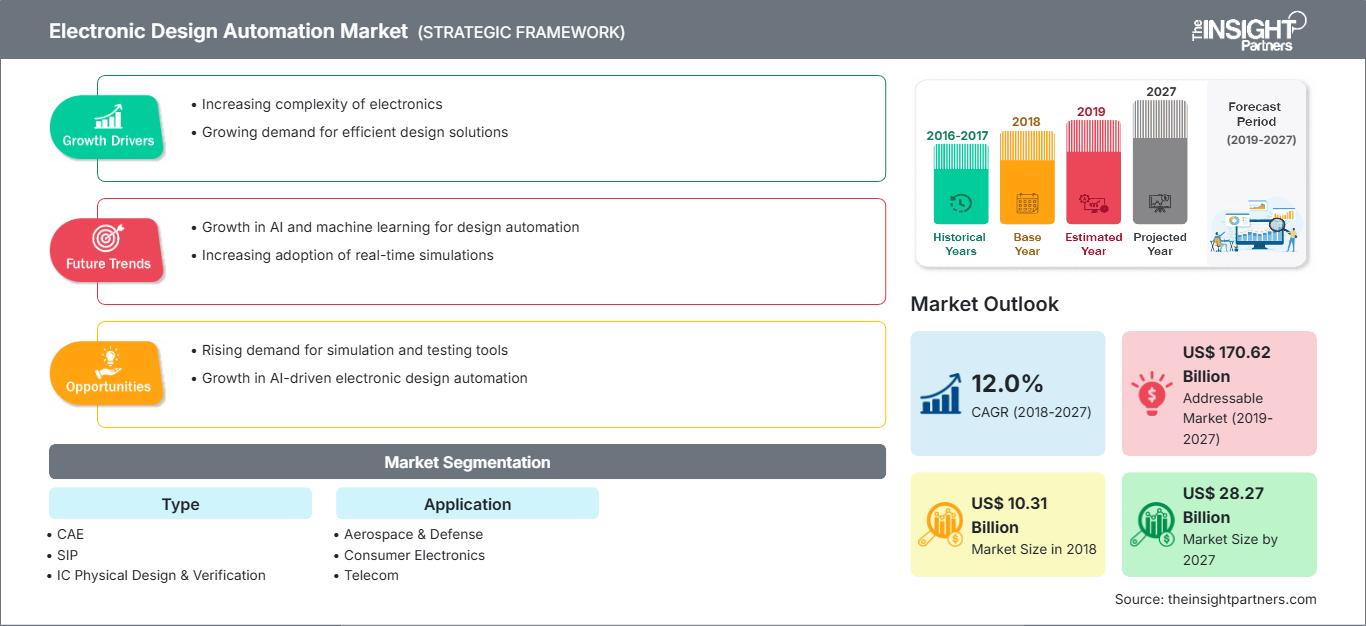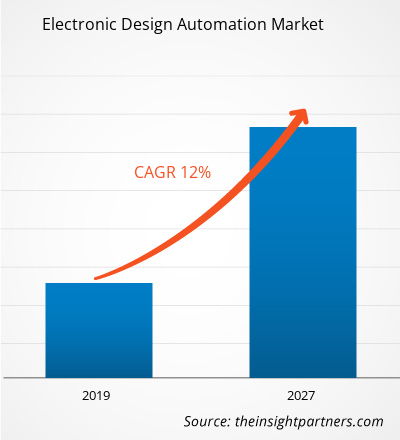Il mercato dell'automazione della progettazione elettronica ha rappresentato 10,31 miliardi di dollari nel 2018 e si prevede che crescerà a un CAGR del 12,0% nel periodo di previsione 2019-2027, fino a raggiungere i 28,27 miliardi di dollari entro il 2027.
Il software di automazione della progettazione elettronica comprende molteplici strumenti e applicazioni. Integrare questi strumenti in base alla domanda dei clienti a volte diventa un compito complicato. I complessi requisiti degli utenti finali in termini di posizionamento del prodotto altamente stabile e accurato vengono affrontati con l'aiuto dell'EDA. Le crescenti complessità e le sfide in termini di costi affrontate dalle industrie per l'implementazione di progetti complessi e costosi sono fattori chiave che guidano la domanda di EDA.Si prevede che l'Asia-Pacifico (APAC) sarà la regione dominante nel mercato dell'automazione della progettazione elettronica. La ragione principale di ciò è l'enorme polo dell'elettronica e dei semiconduttori in Cina, unito all'elevata densità di popolazione della regione. Inoltre, la Cina rappresenta il maggior volume di spedizioni di semiconduttori al mondo; si prevede che le nuove iniziative di mercato e le partnership strategiche continueranno durante il periodo di previsione, contribuendo a un'elevata crescita del mercato dell'automazione della progettazione elettronica nella regione.
Personalizza questo rapporto in base alle tue esigenze
Potrai personalizzare gratuitamente qualsiasi rapporto, comprese parti di questo rapporto, o analisi a livello di paese, pacchetto dati Excel, oltre a usufruire di grandi offerte e sconti per start-up e università
Mercato dell'automazione della progettazione elettronica: Approfondimenti strategici

-
Ottieni le principali tendenze chiave del mercato di questo rapporto.Questo campione GRATUITO includerà l'analisi dei dati, che vanno dalle tendenze di mercato alle stime e alle previsioni.
Nell'ottobre 2018, la SIA (Semiconductor Industry Association), pur rappresentando la leadership statunitense nella ricerca, progettazione e produzione di semiconduttori, ha registrato un aumento del 12,7% rispetto al 2017, con un fatturato totale di 41,8 miliardi di dollari. Inoltre, il WSTS ha previsto una crescita del 15,9% nel 2018 e del 2,6% nel 2019. Questa crescita nell'industria dei semiconduttori ha aumentato la fiducia degli operatori del mercato dell'automazione della progettazione elettronica in termini di crescita del fatturato. Le aziende che operano nel settore dei semiconduttori non solo prevedono un aumento sostanziale del fatturato, ma stanno anche aumentando la spesa in ricerca e sviluppo. L'aumento annuo della spesa in R&S ha imposto una spinta notevole al mercato dell'automazione della progettazione elettronica nel recente passato e si prevede che continuerà a trainarlo nei prossimi anni.
Poiché l'industria dei semiconduttori continua a essere in forte crescita, si prevede che i leader del mercato dell'automazione della progettazione elettronica adottino un approccio orientato al futuro, prendendo in considerazione mercati finali non convenzionali come l'intelligenza artificiale, i veicoli autonomi e l'IoT. Inoltre, è probabile che anche le aziende produttrici di memorie assistano a un aumento delle vendite grazie alla crescente domanda di data center, smartphone e tecnologie per veicoli autonomi. La convergenza di una miriade di mercati finali di semiconduttori ha portato a una significativa espansione del settore, che a sua volta ha trainato il mercato dell'automazione della progettazione elettronica per tecnologia, software e automazione.
Crescente penetrazione di IoT, intelligenza artificiale e realtà virtuale
Case intelligenti, TV, smartphone, Internet of Things, auto connesse e intelligenza artificiale sono tutti aspetti della vita umana che l'industria dell'elettronica di consumo ha permeato. La domanda di elettronica di consumo in tutto il mondo è stata in gran parte trainata dal desiderio dei consumatori di funzionalità più ampie, innovative e migliorate, che a sua volta ha incoraggiato il settore a esplorare costantemente innovazioni e tecnologie che non solo esaudiscano l'immaginazione delle persone, ma siano anche accessibili e pertinenti in termini di soddisfazione delle loro esigenze quotidiane. In questi casi, i fornitori di software EDA si rivolgono ai produttori di componenti elettronici e ai tecnologi per progettare prototipi adeguati dei dispositivi. Pertanto, si prevede che l'evoluzione delle aspettative dei consumatori e la crescente domanda di elettronica di consumo guideranno il mercato EDA nei prossimi anni.
Di seguito sono elencate alcune delle recenti strategie di alcuni degli attori del mercato dell'automazione della progettazione elettronica:
2018: Cadence Design Systems, Inc. ha annunciato una partnership strategica con Green Hills Software per accelerare la sicurezza e la protezione integrate. Cadence Design Systems, Inc. ha investito 150 milioni di dollari, pari a circa il 16% della partecipazione in GreenHill. 2018: Keysight Technologies è stata selezionata da ON Semiconductor come partner EDA per la fornitura di una soluzione di progettazione per dispositivi di potenza che dovrebbe aumentare l'affidabilità e accelerare il time-to-market. 2018: Synopsys, Inc. e Siemens AG hanno annunciato una collaborazione per un'ampia gamma di progetti EDA. Inoltre, Siemens e Synopsys hanno risolto tutte le controversie brevettuali in sospeso tra Synopsys e Mentor Graphics.
Il rapporto segmenta il mercato globale dell'automazione della progettazione elettronica come segue:
Approfondimenti regionali sul mercato dell'automazione della progettazione elettronicaLe tendenze regionali e i fattori che influenzano il mercato dell'Electronic Design Automation durante il periodo di previsione sono stati ampiamente spiegati dagli analisti di The Insight Partners. Questa sezione illustra anche i segmenti e la geografia del mercato dell'Electronic Design Automation in Nord America, Europa, Asia-Pacifico, Medio Oriente e Africa, America Meridionale e Centrale.
Ambito del rapporto di mercato sull'automazione della progettazione elettronica
| Attributo del rapporto | Dettagli |
|---|---|
| Dimensioni del mercato in 2018 | US$ 10.31 Billion |
| Dimensioni del mercato per 2027 | US$ 28.27 Billion |
| CAGR globale (2018 - 2027) | 12.0% |
| Dati storici | 2016-2017 |
| Periodo di previsione | 2019-2027 |
| Segmenti coperti |
By Tipo
|
| Regioni e paesi coperti |
Nord America
|
| Leader di mercato e profili aziendali chiave |
|
Densità degli attori del mercato dell'automazione della progettazione elettronica: comprendere il suo impatto sulle dinamiche aziendali
Il mercato dell'automazione della progettazione elettronica è in rapida crescita, trainato dalla crescente domanda degli utenti finali, dovuta a fattori quali l'evoluzione delle preferenze dei consumatori, i progressi tecnologici e una maggiore consapevolezza dei vantaggi dei prodotti. Con l'aumento della domanda, le aziende stanno ampliando la propria offerta, innovando per soddisfare le esigenze dei consumatori e sfruttando le tendenze emergenti, alimentando ulteriormente la crescita del mercato.

- Ottieni il Mercato dell'automazione della progettazione elettronica Panoramica dei principali attori chiave
Mercato globale dell'automazione della progettazione elettronica - Per tipo
- Ingegneria assistita da computer (CAE)
- IP dei semiconduttori (SIP)
- Progettazione fisica e verifica dei circuiti integrati
- Schede a circuito stampato (PCB) e moduli multi-chip (MCM)
Mercato globale dell'automazione della progettazione elettronica - Per applicazione
- Aerospaziale e Difesa
- Elettronica di consumo
- Telecomunicazioni
- Automotive
- Industriale
- Altro
Mercato globale dell'automazione della progettazione elettronica - Per area geografica
- Nord America
- Stati Uniti
- Canada
- Messico
- Europa
- Francia
- Germania
- Italia
- Spagna
- Regno Unito
- Resto d'Europa
- Asia Pacifico (APAC)
- Cina
- India
- Giappone
- Corea del Sud
- Resto dell'APAC
- Resto del mondo (RoW)
- Sud America
- Medio Oriente e Africa
Mercato globale dell'automazione della progettazione elettronica - Profili aziendali
- Agnisys Inc.
- Aldec, Inc.
- Autodesk, Inc.
- Cadence Design Systems, Inc.
- Labcenter Electronics Ltd.
- Keysight Technologies
- Mentor Graphics Corporation
- Silvaco, Inc.
- Synopsys, Inc.
- Zuken Inc.
- Analisi storica (2 anni), anno base, previsione (7 anni) con CAGR
- Analisi PEST e SWOT
- Valore/volume delle dimensioni del mercato - Globale, Regionale, Nazionale
- Industria e panorama competitivo
- Set di dati Excel
Report recenti
Testimonianze
Motivo dell'acquisto
- Processo decisionale informato
- Comprensione delle dinamiche di mercato
- Analisi competitiva
- Analisi dei clienti
- Previsioni di mercato
- Mitigazione del rischio
- Pianificazione strategica
- Giustificazione degli investimenti
- Identificazione dei mercati emergenti
- Miglioramento delle strategie di marketing
- Aumento dell'efficienza operativa
- Allineamento alle tendenze normative






















 Ottieni un campione gratuito per - Mercato dell'automazione della progettazione elettronica
Ottieni un campione gratuito per - Mercato dell'automazione della progettazione elettronica